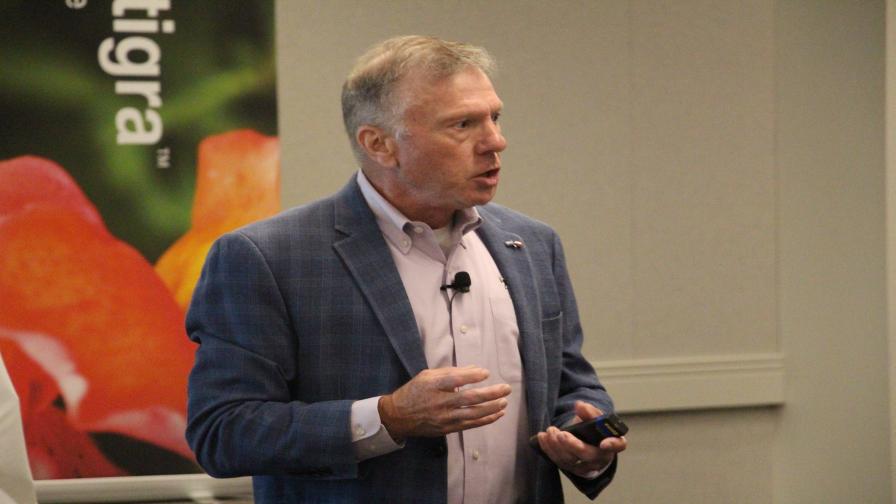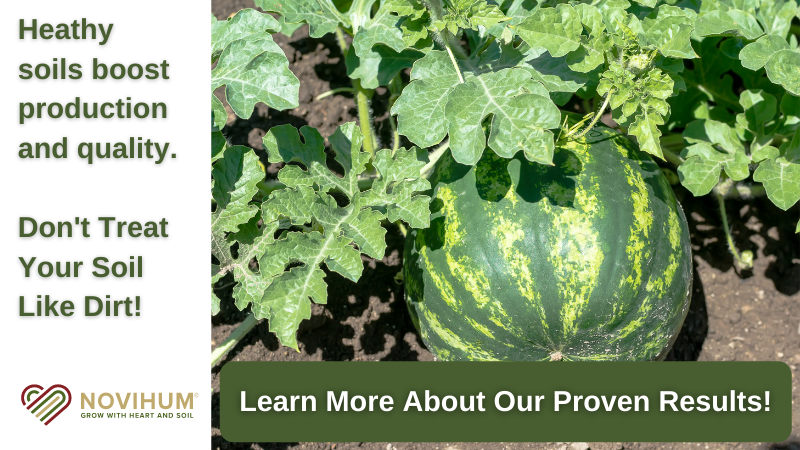5 Big Supply Chain Changes That Growers Need to Be Ready For

Texas Christian University’s (TCU) Dave Malenfant gives his presentation on the evolving nature of supply chain logistics in agriculture at the annual Greenhouse Grower Top 100 Breakfast during Cultivate ’19 in Columbus, OH.
Shipping and logistics are one of the most complex and ever-changing aspects of production agriculture, an undeniable fact that rings especially true in the production and delivery of fresh produce.
Dave Malenfant, Director at the Center for Supply Chain Innovation, Texas Christian University (TCU) Neely School of Business, is a 30-plus year industry veteran and expert of supply chain logistics.
Malenfant recently gave a talk on the rapidly evolving world of digital-based shipping and logistics at American Vegetable Grower sister pub Greenhouse Grower’s annual Top 100 Grower Breakfast during Cultivate ’19 in Columbus, OH.
While primarily focused on the greenhouse and protected ag industries, I couldn’t shake the feeling that an awful lot of Malenfant’s presentation applies to the world of fresh field veggies, too.
“I believe in supply chain management that right now we are in the midst of a transformational digital ecosystem change,” Malenfant says. “I am proposing we go back to the basics – People, Processes, and Technology – and we really take a hard look at how we fully integrate our value chain and our networks and bring it all together.”
The Amazon Effect
What sparked this scattering wildfire of supply chain innovation?
Malenfant and his TCU cohorts argue that retail giant Amazon has essentially re-imaged and redefined supply chain logistics in the 21st century, and that no matter what industry you serve if you’re still shipping and delivering in the same way you were before Bezos and Co. came on the block, then you’re already behind the eight ball.
“Do you think Amazon has Amazon Prime because they love you?” Malenfant asks. “No, they have Prime because they know what you want to buy before you do.”
The growing interconnectedness of all things digital, often referred to as the Internet of Things (IoT), and the coming proliferation of connected “smart cities” is another factor driving the very supply chain innovation that Amazon and others have spearheaded.
“Arlington, TX, is going to be a Smart City where everything will be connected, whether its public safety or connected factories, even connected aircraft,” Malenfant says. “Is your growing operation connected to your logistics suppliers? And is that connected with your customer? Can I go on my smartphone and on an app and order your product and you see it on the screen on your farm so you can ship it? Or are we shipping it to Big Box?”
Product + Data as a Platform
Another fundamental change Malenfant is seeing in supply chain is how products themselves are sold and marketed. As a producer you must embrace the mindset that you’re no longer just selling an apple, or a bundle of fresh carrots, you’re selling the entire customer experience around that apple, and that effects how you ship and deliver product to market.
“You’ve got the little sticker on the apple with a QR code, and now you can scan it and it will tell you what tree and what farmer that apple came from,” he says. “And it will also tell you ‘Here’s a great apple recipe’ or ‘Here’s some other apple varieties you can buy.’ We’re no longer selling just the apple, but we’re selling all the information around it. They’re selling platforms.”
This changes the way manufacturers, retail, everyone in the supply chain interacts with customers, and in turn how products are delivered to those customers.
“We are now becoming more complex and demand-driven,” Malenfant says. “We must understand what our customer wants and when they want it, instead of just making stuff and sending it to market.”
Still, like other segments of agriculture like precision agriculture that have already underwent the digital transformation of Industry 4.0, people will remain a valuable part of the equation in fresh produce shipping and logistics, according to Malenfant.
“Yes, there are solutions out there that can do data processing and analytics, these things are out there and available for use, but it still comes down to people,” he says. “And having the right people that can build processes and enable you to accomplish all your goals around technology, that’s what’s important today.
“Don’t be fooled by all the buzz words, it’s back to basics. People. Processes. Technology.”
Five Trends that Are Impacting Supply Chain Right Now
- Explosive E-Commerce Growth: Most industries are seeing double digit growth in consumer use of e-commerce platforms. Malenfant says this has led to many carriers simply going belly-up “because of the growth of e-commerce and the need for the last quarter mile shipment where now the long-haul truck load is not going to be sufficient.”
- Re-urbanization of America: From aging Baby Boomers to Millennials, it seems our society is returning to the mostly urban living preference of the first Industrial Revolution, when rural families fled rural life in large numbers for the promise of job opportunity in the northern cities. Which means, according to Malenfant, that growers and shippers must find new ways to deliver fresh produce to, for example, the 23rd floor of an apartment building in downtown Philadelphia. Add in the current political climate around shipping – several administrations of major American cities are reportedly looking to restrict the amount of trucks allowed on city streets during the day – and it’s easy to see that shipping and logistics are going to look a whole lot different in the coming months and years than it does today. “The reurbanization of America means more vertical deliveries, and taking goods up into buildings where we haven’t delivered before,” Malenfant says.
- Data First Everything: Just as food processors and consumers are putting greater pressure on producers to document and make available data from every step of the production process (Track and Trace, Farm to Fork), data is revolutionizing how shipping businesses go-to-market. “On-demand, app and location-based trucking is becoming more disruptive,” Malenfant says. “That’s going to be the new way of transacting business (in logistics), and the whole shipping industry is starting to change in this direction. The carriers that are unable to do geolocating (ie pinpointing exact physical addresses for seamless delivery) are going to fall behind.”
- Artificial Intelligence Proliferation: Malenfant sees an industry that desperately needs automated trucking, which tech giants like Google, Tesla (program has since been shuttered), and Uber via its controversial Otto spinoff, have already begun tackling. The economics of how driverless freight will change fresh produce logistics are crystal clear on their own, and Malenfant also foresees ancillary benefits like making long haul trucking more of a viable, sought after profession for today’s digital focused workforce.
- Consumer Need for Speed and Freshness: Malenfant says that all the research his group at TCU has undertaken speaks to the fact that today’s consumer puts product freshness and speed of delivery above all else during product evaluations, and they’ll even pay more for it, too. “If you can’t prove that your product is fresh and grown in clean dirt with none of the nasty chemicals that consumers don’t like, then you will lose that business,” he says. “And we want direct to consumer. No longer will we leave the house and go pick it up down the street. We want it delivered to our door, in a couple of hours. We won’t wait to have it delivered tomorrow.”
The Take Home Message?
The overall takeaway from Malenfant’s presentation?
Change is coming, it’s coming fast – whether it’s in shipping and logistics or in any other aspect of agriculture on this planet – and if you’re not ready for it you might get flattened like a bug on the windshield.
“The pace of change is so fast that what you’re doing today, you won’t be doing tomorrow, and the type of data that is important today will be something different tomorrow,” he says. “A year from now, everything is going to turned upside down. We are faced right now every week with another carrier going bankrupt, because they are stuck trying to change things incrementally. As an industry we better be ready to embrace transformational change, or we’ll go the way of Sears, too.”










